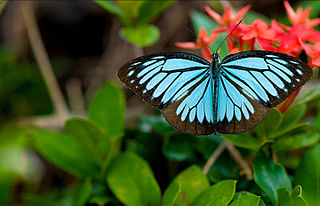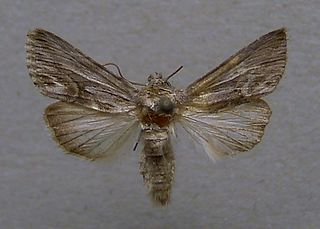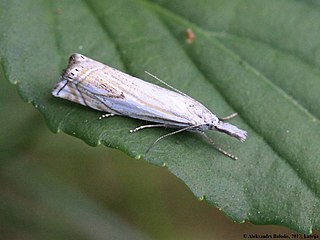
Apamea crenata, known as the clouded-bordered brindle, is a moth in the family Noctuidae. It is distributed throughout the Palearctic realm. In the North it crosses the Arctic Circle, in the Mediterranean it is found only in cool locations and mountains avoiding very hot areas. In the Alps, it rises to an altitude of about 2000 metres.

Pareronia valeria, the common wanderer or Malayan wanderer, is a medium-sized butterfly of the family Pieridae, that is, the yellows and whites, and is found in India and Southeast Asia. The butterfly found in India is sometimes considered as a separate species, Pareronia hippia.

Globia sparganii, or Webb's wainscot, is a moth of the family Noctuidae. The species was first described by Eugenius Johann Christoph Esper in 1790. It is found in Europe, Central Asia, from southern Siberia to Manchuria, Korea, Turkey, Syria and Iran.

Cataclysta lemnata, the small china-mark, is a moth species of the family Crambidae. It is found in Europe, Morocco and Iran.

Nymphula nitidulata, the beautiful china-mark, is a species of moth of the family Crambidae described by Johann Siegfried Hufnagel in 1767. It is found in Europe, Japan (Hokkaido), Turkey, Armenia, Russia and China.

Parapoynx stratiotata, the ringed china-mark, is a moth of the family Crambidae. The species was first described by Carl Linnaeus in his 1758 10th edition of Systema Naturae. It is found in Europe where the distribution area extends in the north to the British Isles including Ireland and in the south to Sardinia, Sicily and Greece. The species is also found across the Palearctic in North Africa, Lebanon, Turkey, Azerbaijan, Kyrgyzstan, Uzbekistan and China..

Catocala sponsa, the dark crimson underwing, is a species of moth of the family Erebidae. It is found in Europe, North Africa and from Anatolia up to the Caucasus.

Mesapamea secalis, the common rustic, is a moth of the family Noctuidae. The species was first described by Carl Linnaeus in his 1758 10th edition of Systema Naturae. It is found in Europe, north-west Africa, Turkey and northern Iran.

Lygephila craccae, the scarce blackneck, is a moth of the family Erebidae. It is found in temperate Europe and across the Palearctic to the Altai Mountains, Korea, Japan and China.

Grammodes stolida, the geometrician, is a moth of the family Erebidae. The species was first described by Johan Christian Fabricius in 1775. It is found in Africa, southern Europe, most of Asia and Australia. It migrates to central and northern Europe as far north as England, Denmark and Finland.

Calophasia platyptera, the antirrhinum brocade, is a moth of the family Noctuidae. The species was first described by Eugenius Johann Christoph Esper in 1788. It is found in Europe, the Near East, the western Sahara, Morocco, Algeria and Tunisia.

Crambus uliginosellus is a species of moth in the family Crambidae. It was first described by Zeller in 1850 and is currently found in most of Europe, except Portugal, Slovenia, Croatia and Ukraine.
Roxita adspersella is a moth in the family Crambidae. It was described by Pieter Cornelius Tobias Snellen in 1893. It is found in Sri Lanka.
Tabidia obvia is a moth in the family Crambidae. It was first described by Xi-Cui Du and Hou-Hun Li in 2014. It is found in China in Gansu, Hubei, Chongqing, Sichuan, Guizhou, Zhejiang and Guangdong.
Polygrammodes sanguifrons is a moth in the family Crambidae. It was described by George Hampson in 1913. It is found in Peru.
Polygrammodes supremalis is a moth in the family Crambidae. It was described by William Schaus in 1920. It is found in Paraná, Brazil.
Sameodes microspilalis is a moth in the family Crambidae. It is found in Zimbabwe.
Udea binoculalis is a moth in the family Crambidae. It was described by George Hampson in 1904. It is found on the Bahamas.
Ardozyga thyrsoptera is a species of moth in the family Gelechiidae. It was described by Edward Meyrick in 1904. It is found in Australia, where it has been recorded from Queensland.
Lecithocera lamprodesma is a moth in the family Lecithoceridae. It was described by Edward Meyrick in 1922. It is found on Sulawesi in Indonesia.











